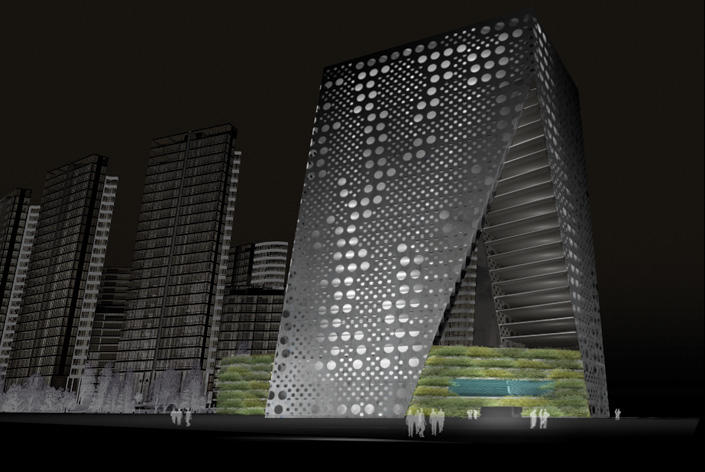Introduction
Bernard Tschumi is a contemporary architect and pedagogue, as well as a notable writer. The following paper is intended to provide a theory review of his Architecture and Disjunction, in which the author considers, discusses, and substantiates his fascinating architectural theories. Therefore, this paper will investigate one of his most interesting theories, described in his work as the Architectural Paradox.
Tschumi’s Theory
Bernard Tschumi draws on a plethora of proposals, ideas, and arguments in his discussions that make it easier for the reader to obtain a fuller view and understanding of the author’s statements and deliberations. Nevertheless, it is essential to outline the main topic of the book in order to remain in a nonverbal correspondence with this author. In my opinion, the main thought and concept of Architecture and Disjunction lie in Tschumi’s understanding of his architectural practice, which says that not everything that is depicted on the architect’s blueprint has anything in common with an existing erection (Tschumi, 1996, p. 7, para. 0).
The main theory of this book and Tschumi’s entire career is the Architectural Paradox. “The statement highlights the dialectic relationship between architectural theory and architectural practice, in much the same way as the central dialectic between ideal space and real space in the essay, “The Architectural Paradox” (Park, 2015, p. 90, para. 5). The author claimed that every idea that might be developed as an item of electronic information or a project on paper sheets must be reconsidered by engineers multiple times because the architect’s work is more like a piece of art than a practical physical object (Tschumi, 1996, p. 41, para. 3).
Moreover, he maintained that any relationship between a human being and any architectural erection involves violence because it implies the human bodily intervention in a particular space, which breaks its order and natural structure.
However, the most notable of Bernard Tschumi’s theories is called the Architectural Paradox, which I had the chance to review and conceptualize after reading his book. In this work, the author also tried to deliver his understanding of space to a reader. The Architectural Paradox uses such mysterious creations as pyramids and a labyrinth in order to explain what space is (Tschumi, 1996, p. 1, para. 0). Tschumi (1996, p. 53, para. 3) also claimed that space has been used to represent and demonstrate the particular ideas and thoughts of humans since the new era’s beginning. Moreover, he opined that such ideas are always affected by various economic and social aspects of contemporary society, regardless of various time limits (Tschumi, 1996, p. 101, para. 7).
The author wanted his readers to understand that every physical intervention or interaction between humans and space throughout history was not an accident because our ancestors wanted to leave some signs that would allow their descendants to be able to read and grasp the nature of space.
Another idea expressed by Tschumi was originally initiated by the movement of felt space and other modern architectural streams. The author stressed that the current generation perceives architecture through the use of various senses (Tschumi, 1996, p. 235, para. 12). In theory, this approach to architectural erections contributes to people’s relations and interaction with space and vice versa. To conclude his findings, Tschumi (1996, p. 1, para. 0) said that every successful space is obliged to contain sensual interaction and language that would be beneficial for people towards having a certain connection with it.
The Architectural Paradox theory contains more than sixty-five rhetorical questions that are intended to make a reader think along with the author and arrive at the same conclusions that Tschumi did. All these questions are aimed at understanding the nature of a space and its primary destination. For instance, the author debated the topic of the infinity of space that seemed unclear to him because it remained contained at the same moment.
The Author’s Strategies and Approach to his Work
Tschumi used various strategies to prove and substantiate the theory that he developed and described in Architecture and Disjunction. The most common strategies and methods, which have helped the author to express his extraordinary opinion, can be categorized as sensorial, visual, and cultural; he compared the human mind and thought with architectural objects (Lemer, 2013, p. 161). He also analyzed and evaluated invisible space and its relation to humanity and people’s minds.
Tschumi’s proposal differs from the theories and statements of other authors in this sphere by its obliquity as well as the effort that every reader is required to make in order to obtain the full image along with a clear understanding of this theory. Moreover, Bernard Tschumi appeared to think that architecture plays a significant role in establishing political and personal freedom (Tschumi, 1996, p. 35, para. 2).
Many of the author’s works (including the Architectural Paradox theory) are overwhelmed with political and ethical imperatives that influence his professional activity by putting more emphasis and cultural balance in every object that is erected on the basis of Tschumi’s projects. According to the writer’s theory, every piece of architecture is intended to help in considering and evaluating the existing social structure rather than merely supporting it (Ching, 2014, p. 417).
Nowadays, many building projects refer to a particular style. This fact did not satisfy the author because he wanted new buildings to be different, extravagant, and innovative; such pieces of architecture would set new standards of fashion design (Lemer, 2013, p. 15, para. 1). Instead, many engineers just take and develop one another’s ideas.
Discussion
The proposal of the strategies above is different from others’ ideas because the mutual goal of these thoughts is to promote and imply the progress of civilization and to set a proper balance between humans and various inventions. Tschumi was concerned about the fact that people have become more skeptical and careless about a wide range of new inventions and buildings as humanity’s growth is almost unstoppable nowadays (Tschumi, 1996, p. 21, para. 1).
Therefore, people care less about surrounding objects due to the fleeting nature of life. Tschumi’s theories propose a new approach and relation to architecture aimed to increase people’s attention to new erections by implementing revolutionary styles, displaying their creators’ original vision along with their understanding of space (Tschumi, 1996, p. 21, para. 1). The Architectural Paradox theory also says that today’s buildings look similar and unoriginal, in contrast to those of ancient generations, who invented a plethora of architectural objects that formed and popularised their countries’ cultures, traditions, customs, and religious beliefs.
As mentioned earlier, Bernard Tschumi used particular historical precedents to substantiate the claims inherent in his main theory. The Architectural Paradox theory is based on such magnificent objects of professional engineering as the Egyptian pyramids, the Tower of Babel, the Minotaur’s Labyrinth, and many others (Tschumi, 1996, p. 1, para. 0). The author’s theory says in part that contemporary architects are not able to erect something similar to the aforementioned historical objects.
Bernard Tschumi also criticized multiple works by other architects and authors who support, develop, and popularise modernist ideology because this offshoot of architecture has particular limitations. Due to their restrictions, the cultural conditions and traditions of various countries and nations are forgotten even by their native populations. His theory also does not support the idea and philosophy of architectural multipurpose trends (Tschumi, 1996, p. 28, para. 1).
Nowadays, any modern building is suitable for almost anything – equipped offices, calm apartments, business centers, selling areas, and other facilities. However, Tschumi’s theory has faced criticism from his colleagues and competitors as well. Experienced architects have claimed that the author’s works follow and profess a destructive position Moreover, his Architectural Paradox theory is usually judged for disregarding primary human needs for the benefit of uncertain artificial values that have been composed by Tschumi. Unfortunately, some of the author’s architectural objects are not as practical as others. He has preferred to follow his theory and fill the surrounding space with something that will remain interesting and attractive for future generations.
Examples of Bernard Tschumi’s Creations

One of the most interesting images describing and supporting the Architectural Paradox theory of Bernard Tschumi is a picture of Vacheron Constantin Headquarters. The building shown in Figure 1 was constructed over the period from 2001 to 2005 in Geneva, Switzerland. Although the aforementioned theory and the author’s book develop and popularise the idea of people’s comfort and the irrelevance of practical accommodations, this building seems to be convenient enough with regard to an office space. Its shape is perhaps somewhat out of the ordinary because the ground floor of this construction is narrower than the two floors above (Dwyre, Perry, & Tschumi, 2015, p. 10). In turn, the windows of this building make a straight line on each floor, but their height and width are reduced to a minimum size, which might be inconvenient due to the lack of sunlight for people who are obliged to work here every day.

Another image that clearly describes the style of Bernard Tschumi and correlates to his Architectural Paradox theory is the picture of the Tower in Beijing, built-in 2004. The tower shown in Figure 2 is situated in the central district of China’s capital and functions as a building for one of the local hotels and flat complexes. However, this erection also implies the full concept of the aforementioned theory because its accommodations are not suitable for comfortable living due to its leaning and skewed shape (Kärrholm, 2012, p. 51, para. 2).
The building’s circular windows add to the stunning appearance of this architectural construction. Its windows are also designed to provide enough lighting to the Tower’s interior. Nevertheless, its shape is not appropriate for housing because people who live in separate (lower) parts of this construction are obliged to go outside in order to walk to the other end of their house. This building is also inconvenient for providing such governmental services as plumbing, sewage, gas-mains, and other installations that are essential for the local population.
Conclusion
Bernard Tschumi is a notable architect who developed the theory of Architectural Paradox. According to this philosophy, modern architecture does not suit the surrounding space as architecture did in ancient epochs. The author’s discourse also covered his understanding of space, that every building has to have a certain sense that will be discovered and inherited by future generations. While some of his professional works follow this theory and remain inconvenient, they appear extraordinary to people who are used to the usual urban architecture style.
References
Ching, F. (2014). Architecture: Form, space, and order (4th ed.). New Jersey, NJ: Wiley & Sons.
Dwyre, C., Perry, C., & Tschumi, B. (2015). Architecture beyond architecture. PAJ: A Journal of Performance and Art, 37(1), 8-15. Web.
Kärrholm, M. (2012). Retailising space: Architecture, retail and the territorialisation of public space. Farnham, UK: Ashgate.
Lemer, A. C. (2013). Architectural theories of the environment: Posthuman territory. Construction Management and Economics, 31(11), 1162-1164. Web.
Park, H. (2015). A study on the meaning of in-between space in Sou Fujimoto and Bernard Tschumis architecture. Korean Institute of Interior Design Journal, 24(6), 87-95. Web.
Tower in Beijing [Image]. (2004). Web.
Tschumi, B. (1996). Architecture and disjunction. London, UK: MIT Press.
Vacheron Constantin headquarters [Image]. (2005). Web.